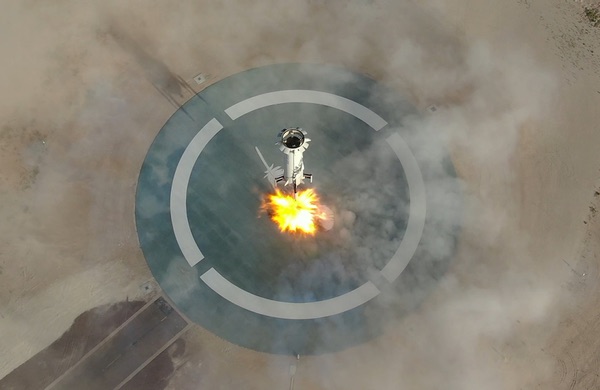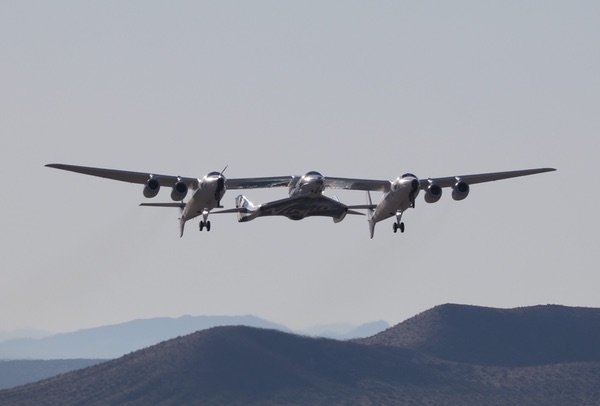Suborbital space tourism nears its make-or-break momentby Jeff Foust
|
| “The way it flew on that flight was as good as I could ever have hoped for,” Mackay said of the February test flight of SpaceShipTwo. |
Astronauts, though, are an exception: especially commercial astronauts wearing distinctive black flight suits. Three Virgin Galactic astronauts—Dave Mackay, Mike Masucci, and Beth Moses—arrived for an interview about 20 minutes late during the conference last month, but they had a good excuse: it’s tough to get across the sprawling grounds of The Broadmoor, where the conference takes place, they said, when people want to meet you and get their pictures taken with you.
Earlier that day, the three were on stage at the conference to formally receive their commercial astronaut wings from Wayne Monteith, the FAA’s associate administrator for commercial space transportation. They were the fifth, sixth, and seventh people to receive such wings, which the FAA awards to flight crews of commercial spacecraft that fly to an altitude of at least 50 miles (about 80 kilometers), joining the Virgin Galactic pilots who flew SpaceShipTwo beyond that altitude for the first time last December as well as SpaceShipOne pilots Mike Melvill and Brian Binnie.
Mackay, Masucci, and Moses were on the most recent SpaceShipTwo flight February 22, when the vehicle flew to an altitude of nearly 90 kilometers above the Mojave Air and Space Port in California. That flight duplicated the success of the December flight that carried it beyond the US government’s definition of space for the first time (see “SpaceShipTwo finally makes it to space*”, The Space Review, December 17, 2018).
“The way it flew on that flight was as good as I could ever have hoped for,” Mackay, Virgin Galactic’s chief pilot, said of the February flight. “I was delighted with the way the vehicle flew.”
He said he and the other pilots trained for the worst. “We practice every day, almost, in the sims,” he said. “We see some bad things in the sims, some worst-case scenarios.” SpaceShipTwo, he said, flew better than even the best-case scenarios in the simulator. For example, he said the vehicle required less use of its reaction control system (RCS) while in space than in any simulator.
Masucci, the co-pilot on the flight, concurred. “This time seemed even smoother,” he said. At apogee, he noted how quiet it was. “To take that all in was very surreal.”
Reentry, though, wasn’t quiet, as the spacecraft encountered the atmosphere. “What I didn’t expect was how visceral entry felt,” Moses said. “Entry was dramatic.”
“As we reenter, the noise of the airflow hitting the underside of the vehicle was really loud,” Mackay said. “It kind of delineates the boundary between space, that space experience, and the atmosphere. It emphasizes that you have actually been to a special place and now you’re coming back.”
Moses was in the cabin of SpaceShipTwo, evaluating the experience from the perspective of future customers. “My cabin evaluation turned out to be very textbook,” she said. “It went like clockwork. When it was time to get back into my seat, everything lined up to do so. I got all the data, plus, that I wanted to.”
Moses was evaluating not just the technical aspects of the flight experience, but also how people will perceive it. “I knew before the flight, down to the fraction of a second, exactly when certain phases would occur, but some of them felt longer than I had anticipated and some felt shorter,” she said.
An example is the period between the release of SpaceShipTwo from its WhiteKnightTwo aircraft and the ignition of its hybrid rocket motor, a span of just a few seconds. “It felt manyfold longer than I anticipated,” she recalled. Those insights, she said, will help prepare customers in ways that simulators alone can’t.
SpaceShipTwo hadn’t flown again as of that interview, or even as this article was being prepared for publication, more than three months after that February flight. Mackay said in April that the gap between flights would be an extended one.
“This downtime might be fairly long,” he said. “Once we get out of that, we should be able to get through the remainder of the test program pretty quickly and get into commercial service.”
| “As we reenter, the noise of the airflow hitting the underside of the vehicle was really loud,” Mackay said. “It kind of delineates the boundary between space, that space experience, and the atmosphere.” |
One of the reasons for the extended downtime, he said, was to complete the outfitting of the cabin, putting in place the seats and other elements that will be used for commercial flights. “The next time it flies, we expect to have the full commercial cabin installed,” he said. A few other modifications to the vehicle are also in progress, such as changes to cockpit displays.
When those flights do resume, they’ll take place from a different location. At a May 10 press conference in Santa Fe, New Mexico, Virgin Galactic and New Mexico state officials announced that the company was moving operations from Mojave to Spaceport America in the southern part of the state.
More than 100 employees will be moving to New Mexico, the company announced, with the moves timed to take place over the summer, after the end of the school year, to minimize disruption to families. The vehicles themselves—the SpaceShipTwo vehicle known as VSS Unity and the WhiteKnightTwo aircraft called VMS Eve—will move to the spaceport some time this summer “once cabin interior and other work has been completed,” the company said in a statement.
Once both the vehicles and personnel are in place at Spaceport America, test flights will resume, followed by commercial operations. The company, as is standard practice, didn’t disclose a schedule for either the test flights or commercial service. Earlier this year, company founder Sir Richard Branson suggested he would fly on the first commercial flight in July, perhaps around the time of the 50th anniversary of Apollo 11, but that seems unlikely now.
“With these workers here and with these plans firmly in place, I’m certain New Mexico will serve as the launchpad for the rapid industry growth we’ve been expecting for so many years,” New Mexico Gov. Michelle Lujan Grisham said in a statement. That comment hinted at the long delays in getting the company flying from the $200 million spaceport announced by then-Gov. Bill Richardson in 2005 and completed by her predecessor, Gov. Susana Martinez.
 A drone’s-eye view of the propulsion module of Blue OriginÆs New Shepard vehicle making a landing after a May 2 launch. (credit: Blue Origin) |
The New Mexico announcement came a little more than a week after the other company in the final stages of development of a crewed suborbital vehicle, Blue Origin, carried out its latest test flight. The May 2 flight from the company’s West Texas site saw New Shepard vehicle fly to an altitude of nearly 106 kilometers, with its propulsion module making a powered vertical landing shortly before the crew capsule landed under parachutes nearby.
The flight, the 11th in a series going back four years, carried more than three dozen research payloads, including several from NASA’s Flight Opportunities program. (The two most recent SpaceShipTwo test flights also carried Flight Opportunities payloads.) This flight, like all the previous ones, did not have anyone on board.
Blue Origin has taken a very different approach to marketing New Shepard than Virgin Galactic has with SpaceShipTwo. While Virgin started selling tickets more than a decade ago, Blue Origin has yet to start selling tickets or even giving a price, a reticence it’s maintained even while claiming it’s getting ever closer to flying people on the vehicle.
“We’re taking one step closer to flying people on board New Shepard later this year,” Ariane Cornell, head of astronaut strategy and sales at Blue Origin, said during the webcast of the latest New Shepard flight. She noted that the New Shepard crew capsule that will be used for crewed flights, called the RSS First Step—RSS standing for “Reusable Space Ship” and First Step a reference to the company’s long-term vision of millions of people living and working in space—is “in the barn” at the West Texas site.
The company might not be ready to sell tickets, but its founder is willing to differentiate New Shepard with the competition. In an interview in February, Jeff Bezos suggested that the higher altitude New Shepard flies—above the 100-kilometer Karman Line—will give it an advantage over SpaceShipTwo.
| “I can’t wait to start sending humans up in New Shepard later this year,” Bezos said. “It’s a big deal.” |
“One of the issues that Virgin Galactic will have to address eventually is that they are not flying above the Karman Line, not yet. The vehicle isn’t quite capable,” Bezos said. “We’ve always had as our mission that we always wanted to fly above the Karman Line because we didn't want there to be any asterisks next to your name about whether you’re an astronaut or not. And so that’s something they’re going to have to address in my opinion, before they’ll be better.”
He emphasized that when asked if New Shepard customers would indeed fly above the Karman Line: “No asterisks.”
Bezos, speaking at an event in Washington May 9 to discuss his company’s Blue Moon lunar lander (see “Blue Moon and the infrastructure of space settlement”, The Space Review, May 13, 2019), only touched briefly on the development of New Shepard, largely in the context of how it supported the broader plans of the company to develop crewed spacecraft.
“Right from the start, we wanted to build a human-rated system, so we would be forced to think clearly about safety, reliability, escape systems, all the things we knew we would need and have practice with in order to build our next-generation vehicle,” he said. “So it’s all about practice.”
“I can’t wait to start sending humans up in New Shepard later this year. It’s a big deal,” he continued.
“Woohoo!” someone in the audience shouted.
“Thank you,” Bezos responded, then moved on.
Note: we are temporarily moderating all comments subcommitted to deal with a surge in spam.
